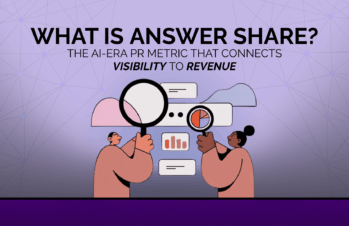Thought leadership comes in many different packages.
There are branded magazines, columns in mainstream publications, blogs, and podcasts. There are Twitter threads and LinkedIn live streams.
The type of format you use depends on a few different factors, but most importantly:
- How you’re most comfortable communicating
- Where your audience spends time online
- Your available resources
If you’re just getting started with thought leadership, it can feel daunting. This post will help you understand some of the many formats you can use, with examples of each type.
Let’s get started!
Blog posts and owned articles
Blog posts and owned articles—think Medium or LinkedIn articles, for example, which anyone can write and post—are probably one of the first things you think of when you’re considering thought leadership.
Since your brand owns this content, it’s obviously the easiest way to get started. There are no gatekeepers, applications, or deadlines (other than your own). You can write this on your own, or have someone on your content or marketing team ghostwrite for you.
Related post: Ghostwriting: Be the Expert, Outsource the Rest
Another benefit of starting with a blog or other owned platform is that you can post as often as you’re able to, helping to generate traffic and boost your brand’s SEO quickly.
If you’re looking to become known as an individual thought leader (in other words, known by your name, not just your company) then it’s critical to ensure that you are posting under your name on your blog. This will be done through your author settings on your content management system—ask your IT team if you don’t know how to set it up yourself.
Example to emulate: HubSpot. Hubspot’s blog is one of the best in the B2B marketing and sales industry, and a perfect example of brand thought leadership (as opposed to individual thought leadership). They post lengthy, substance-rich posts frequently, which has helped them own the conversation on multiple topics related to CRMs, marketing automation, and more.
Contributed articles
Contributed articles are pieces that you submit to other publications, whether you pay for the privilege (these are called sponsored posts) or not.
These types of articles have an advantage over blogs in that you’re reaching a wider audience—and it’s generally an audience that consists of people who’ve never heard of you or your brand.
Plus, If you can get a regular column in a mainstream publication like Forbes or Inc, or in a trade publication, you can gradually build an engaged audience that will not only follow you and share your content more widely, but also get familiar with your company.
Example to emulate: Zen’s CEO and founder, Shama Hyder, writes a regular column in Inc. magazine about tech and marketing tactics. The articles are grounded in her take on the marketing industry, with an eye to trends and the industry’s future.
Branded, owned publications
This is, by far, the most resource-heavy text-based format your thought leadership can take.
A branded publication is a magazine, print or online, that your brand owns and funds. Other than that, however, it’s similar to any other publication—there are articles by multiple writers, photographs, dispatches, etc. While these are owned and operated by a brand, successful ones have to ensure they steer clear of too much self-promotion. This is the case with all thought leadership, but it’s especially important for an undertaking as large as a publication. Readers may forgive a single tactless sentence in a 1000-word article, but if they’re scrolling through your publication and see five or six pushy mentions scattered throughout, they’re much more likely to abandon you.
If your company has the time, money, and bandwidth to create a great branded pub, it can be an opportunity to make a huge impact in your industry.
However, it’s important to note that many brands, even large ones like Airbnb and Casper Mattresses, have embarked on ambitious branded publication efforts, only to shutter them after a few issues.
Example to emulate: Adobe’s CMO.com is one example of a branded publication that’s become an industry standout for thought leadership. With minimal branding and a wide variety of articles by experts from both inside and outside Adobe, the website has become a leader in providing informative and entertaining content for those in the marketing and branding industries.
Podcasts
More comfortable talking than you are writing? Then a podcast may be the right form for your thought leadership to take.
The good news is that the actual making of a podcast requires little more than a strong wifi connection and a good microphone. There’s a low barrier to entry, both in terms of time investment and resource procurement.
However, you’ll need to do more than just turn on the mic and start talking, even if you are a practiced public speaker and know how to hold an audience’s attention. Good podcasts take planning and practice. After all, there are more than 500,000 active podcasts on the internet. To stand out, you’ve got to nail your message, communicate your personality, and continually find engaging topics.
A few pointers to keep in mind:
- Use narrative structures as much as possible to frame your messaging. Narratives are especially helpful for keeping people engaged with audio, which explains the massive popularity of narrative-based shows like This American Life and Serial.
- Err on the side of brevity over length. Especially at the beginning, you may not have enough to fill an hour-long spot, or even 30 minutes.
- Focus on conveying your own personal expertise as well as your personality. You’re asking people to listen to what you have to say—show them why it matters. Share what you know through relevant stories from your life and career, bring in guests who can speak to topics your audience is interested in, and be consistent in what you’re bringing to your listeners. If it’s a podcast about succeeding as a female CMO, then your conversations (or monologues) should always tie back to that main topic.
Examples to emulate: The Distance by Basecamp, which explores wisdom from companies that have been in business for 25 years or more, and The Business Storytelling Podcast, which features content and storytelling tips, as well as interviews, from content marketer Christoph Trappe.
Twitter threads
Ah, the Twitter thread. While once these tended to top out at 7 or 8 connected tweets, now thought leaders are getting bold and posting 20, 25, even 30 connected tweets to create what could be called a kind of Twitter essay.
One of the great things about Twitter threads is that they’re an easy format to experiment with. If you’ve got somewhat of a following already on Twitter, you can try posting longer commentary, broken up into a series of tweets, a few times a week for a few weeks and see what kind of response you get.
If it doesn’t seem to be working, take a look at your hashtags and the kind of content you’re sharing. It may be that you just need to tweak some things—maybe your audience doesn’t typically expect this type of content from you on the platform, and you need to warm them up to it. Or maybe the way you’re breaking up the content isn’t clear and easy to follow.
Example to emulate: This Twitter thread on writing from @EllenRhymes has a clear structure set out in the first tweet, which gives readers an idea of where they’re going as they scroll through each post. She also uses emojis to break up the text and create some visual interest—an important strategy on a text-heavy platform like Twitter.
Live streams
Live streams are another valuable way for thought leaders to connect with their audiences. Even if they’re highly focused and planned (which is always a good idea), live streaming automatically feels more immediate, intimate, and unrehearsed than most of the other formats we’ve discussed.
This makes them a good fit both for thought leaders who can speak off the cuff, without rehearsing, as well as those who like to take a more prepared and planned approach.
If you’re just beginning with live streaming, best practice is to set a date and time, so you can promote the event to your followers. Let them know what you’ll be covering and how they can participate.
As you grow your following, you may reach a point at which you can simply tap the “go live” button and broadcast when you have something you want to say, whether that’s commenting on a development in your industry or sharing a company update.
Examples to emulate: Molbak Garden + Home, which became famous during the pandemic for their gardening tutorial live streams and videos.
Part of growing your thought leadership is figuring out which formats work best for you—and that’s an ongoing process. If you think you may like some help, take a look and see what our team can help you accomplish.




